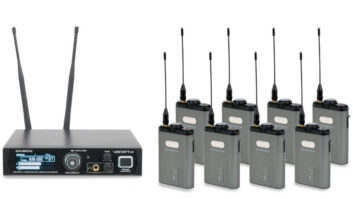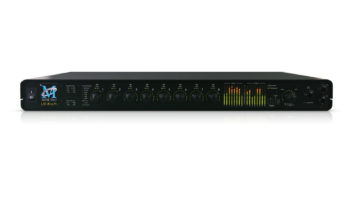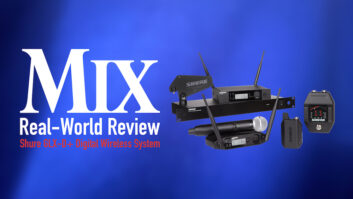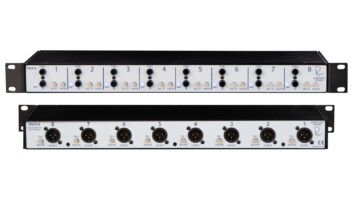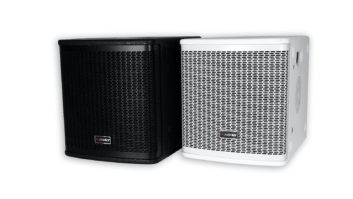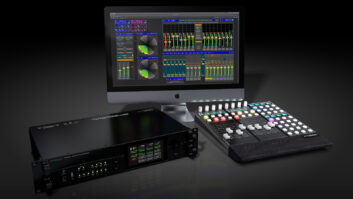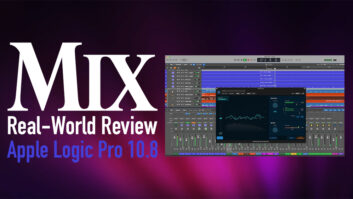No engineer can deny that digital mixing consoles make life easier. Recall of every parameter, built-in dynamics and comprehensive automation are functions that we’ve come to view as necessary. The problem is that just about every digital console lacks a one-control/one-function worksurface, thus requiring the engineer to dig into menus for important parameters and slowing down the process. Optimized for use in live sound and broadcast applications where speed is as important as sonic accuracy, Studer’s Vista 8 modular digital console brings a welcome change, furnishing the engineer with a worksurface where any function is no more than one button push away.
WHAT’S IT ALL ABOUT?
The Vista 8 system comprises the Vista 8 console, a DSP Core, D21m I/Os, a monitoring frame, CPU and optional MasterSync Generator. The DSP Core is a rackmount frame housing up to 20 DSP cards. The D21m I/O frames provide audio I/O, and may be loaded with TDIF, ADAT, AES/EBU, MADI, analog mic input and analog line input or output cards. The monitoring rack is where analog audio is routed out of the system for stereo, LCR, LCRS and 5.1 monitoring. A Vista 8 may be synched via an AES/EBU input; with a MasterSync Generator, the system can also sync to external video or word signals. The Vista 8 system doesn’t come “stock” with a number of I/Os; it is more a case of building a configuration to suit the user’s needs.
The Vista 8 control surface is based on modular bays and uses a Windows-based PC to run Studer’s software for the desk. The Vista 8 comprises one 10-fader master Control Bay and up to six 10-fader Channel Bays. A remote 10-fader control surface may be added, providing remote access to a second engineer. Of course, you can control many more channels than you have physical faders.
The obvious difference between the Vista 8 and other digital consoles is Studer’s exclusive Vistonics” interface, which features patented technology for integrating 40 rotary controls and switches, all within a flat touchscreen display. Combine this with a generous assortment of controls per channel (mute, solo, on/off for EQ, HPF, LPF, delay, dynamics and assignable trim control), and the result is that you look for information where the controls are located, as opposed to turning a knob in one section while looking at a screen in another section.
DIFFERENT POINTS OF VIEW
In Global View, four inline rotaries per channel provide access to settings determined by the Global View buttons; for example, aux level, channel delay, EQ or expander/gate controls. Want to change the EQ? Touch that channel’s EQ curve and the EQ function appears on the panel with knobs for each parameter. (This is called Zoom View.) All controls are in plain view and logically laid out with no digging through menus. Because each Channel Bay has a set of Global View buttons, there’s no need to access the Control Bay to change views: Simply use the closest set of Global View buttons. To dedicate all 40 knobs and switches on the panel to one channel, all I had to do was press the Channel View button.
Separate Copy/Paste buttons are provided for the EQ, filters, delay, pan and dynamics settings. Pressing Copy on the source channel and then again on the destination channel pastes the desired parameters to the destination channel or into a user library. I was able to copy and paste an EQ curve to multiple channels quickly by using the Link/Sel switches to “gang” a set of channels, copying EQ from one and pasting to another. (The paste applies to all channels in the gang.) When I first encountered the Copy/Paste function, I thought it was novel; its ease of use made clear to me how powerful it is.
SONIC CONTROL
EQ, dynamics, delay and panning are on every input or output. EQ is 4-band parametric. The top and bottom bands switch between shelf and parametric. Each band sweeps from 20 to 20k Hz, enabling incredible flexibility. Separate HPF and LPF are provided with adjustable slope (12, 18 or 24dB/octave). Dynamics include separate compressor, limiter, gate and expander with sidechain access, any of which may be switched on or off individually. I was able to get the compressor to massage an audio signal gently or completely squash it, and everything in between.
Panning options are based on output configurations, with the ability to pan in formats from stereo to 7.1. All Vista consoles include Studer’s VSP (Virtual Surround Panning), which is different from amplitude-based panning, employing onboard DSP to also calculate appropriate frequency and time-based changes as a sound is panned. The results are incredibly realistic.
Optimized for output channels, the Vista 8 Control Bay hosts 10 fader strips and a Vistonics screen. These 10 faders are isolated from the remainder of the desk, so I could scroll inputs while the masters remained unaltered. Any type of channel may be assigned to a Control Bay strip, including input, control group, master, aux out or subgroup out. EQ and dynamics can be applied to the output masters, though control group processing is actually applied to the channels that contribute to the group (sort of like VCA groups on steroids). A feature I found extremely useful is the Contribution button, which applies to output faders. When pressed, the Vistonics screen displays all input faders that currently contribute to that particular master; the rotaries control the source channels’ level. If you think that’s slick, then check this out: When Reduced View is switched off, the panel displays all channels available for contribution, and routing assignment can instantly be changed using the push buttons next to the rotaries.
PATCH ROUTING FINESSE
Channel patching and assignment are addressed in the Configuration and Channel Patch Editors. The Configuration Editor is a Windows-based setup app in which you specify the number and type of channels, buses and masters required. The software determines DSP allocation for the setup and lets you know if your aspirations exceed your DSP muscle (smart). It’s possible to configure the console in any manner you imagine and store the configuration to a library.
A patching matrix routes a physical input to any console channel. In less than a minute, my Vista 8 was “expanded” from the day-to-day configuration for a TV show (multiple audience mics, VTR and CD feeds, and host and guest mics) to add a MADI interface for a musical guest who required multitrack playback from Steinberg Nuendo. Returning to the default configuration was just as easy. This is a huge advantage for remote trucks where operations vary from day to day, enabling the desk to be custom-built.
In systems where the number of inputs exceeds the number of faders, channels may be arranged in stacked sections (layers). This allowed me to set one section for microphone inputs and a layer “below” for multitrack returns from a recorder. Graphics above the fader show channel names for both sections and indicate signal level for the related layer. A channel’s L2 button instantly calls the lower layer up for control without altering the other channels. Dedicated buttons provide instant access to different layers. One excellent feature of the Vista 8’s architecture is that a single input can appear on multiple faders. In my configuration, the “star” microphone channel was routed to multiple inputs so that when changing layers, the star appeared in the same place, regardless of layer.
The Channel Patch Editor shows a block diagram of the channel’s signal flow, including position of EQ, dynamics, filters and inserts relative to the fader. I was easily able to move the insert patch from pre- to post-fader simply by opening this window and dragging the insert to the desired location. Outstanding!
FAIL-SAFE OPERATION
The Vista 8 features extensive backup capabilities including redundant power supplies for the DSP Core and D21m. In the event of a power failure, the DSP Core reboots within a few seconds, restoring audio even if the control surface is inactive. If a card in the DSP rack fails, then the Core automatically switches to a spare card. In my system, this switch-over barely produced an audible glitch.
Data mirroring on the PC provides complete backup of console operations to a second computer. In the event of a primary PC failure, a hot button switches the desk to the backup CPU. Even if the CPU fails, the DSP Core remains online in its last state. Audio continues to pass at the last mix settings until the new CPU comes back online. The optional MasterSync Generator has two main clock inputs; if one fails, then the other automatically takes over.
POWERFUL AUDIO WORKHORSE
There’s so much available on this console it would take a volume to describe every function — I haven’t even discussed Vista 8’s dynamic and snapshot automation, mute grouping and mix-minus capabilities. The big story here is Studer’s software. No messing around, these guys did their homework. This is one of the most powerful audio consoles you’ll ever lay your hands on.
The user interface is fast, logical and elegant. Faders and knobs have that great Studer feel, and I never experienced any noise when dialing parameter changes across the range. Construction is first rate, with an incredible attention to detail and close mechanical tolerances. Though the control surface looks complicated, it didn’t take me long to get up to speed. Couple that with extensive redundancy and high-quality sound, and the Vista 8 is a formidable console for professional live, broadcast and recording applications.
Price: approximately $200,000 to $500,000, depending on configuration.
Studer USA, 818/920-3206, www.studer.ch.
Steve La Cerra is a freelance engineer, producer and writer based near New York City.
